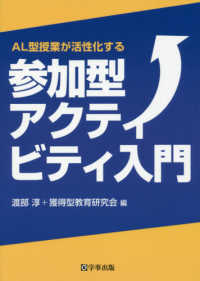- ホーム
- > 洋書
- > ドイツ書
- > Mathematics, Sciences & Technology
- > Chemistry
Full Description
Electrochromic materials can change their properties under the influence of an electrical voltage or current. Different classes of materials show this behavior such as transition metal oxides, conjugated polymers, metal-coordinated complexes and organic molecules. As the color change is persistent, the electric field needs only to be applied to initiate the switching, allowing for applications such as low-energy consumption displays, light-adapting mirrors in the automobile industry and smart windows for which the amount of transmitted light and heat can be controlled.
The first part of this book describes the different classes and processing techniques of electrochromic materials. The second part highlights nanostructured electrochromic materials and device fabrication, and the third part focuses on the applications such as smart windows, adaptive camouflage, biomimicry, wearable displays and fashion. The last part rounds off the book by device case studies and environmental impact issues.
Contents
Preface xix
Acknowledgements xxi
List of Contributors xxiii
Part I Electrochromic Materials and Processing 1
1 Electrochromic Metal Oxides: An Introduction to Materials and Devices 3
Claes-Göran Granqvist
1.1 Introduction 3
1.2 Some Notes on History and Early Applications 5
1.3 Overview of Electrochromic Oxides 6
1.4 Transparent Electrical Conductors and Electrolytes 23
1.5 Towards Devices 30
1.6 Conclusions 33
Acknowledgement 33
References 33
2 Electrochromic Materials Based on Prussian Blue and Other Metal Metallohexacyanates 41
David R. Rosseinsky and Roger J. Mortimer
2.1 The Electrochromism of Prussian Blue 41
2.2 Metal Metallohexacyanates akin to Prussian Blue 48
2.3 Copper Hexacyanoferrate 49
References 50
3 Electrochromic Materials and Devices Based on Viologens 57
Paul M. S. Monk, David R. Rosseinsky, and Roger J. Mortimer
3.1 Introduction, Naming and Previous Studies 57
3.2 Redox Chemistry of Bipyridilium Electrochromes 58
3.3 Physicochemical Considerations for Including Bipyridilium Species in ECDs 61
3.4 Exemplar Bipyridilium ECDs 72
3.5 Elaborations 78
References 81
4 Electrochromic Devices Based on Metal Hexacyanometallate/Viologen Pairings 91
Kuo-Chuan Ho, Chih-Wei Hu, and Thomas S. Varley
4.1 Introduction 91
4.2 Hybrid (Solid-with-Solution) Electrochromic Devices 93
4.3 All-Solid Electrochromic Devices 97
4.4 Other Metal Hexacyanometallate-Viologen-Based ECDs 104
4.5 Prospects for Metal Hexacyanometallate-Viologen-Based ECDs 105
References 106
5 Conjugated Electrochromic Polymers: Structure-Driven Colour and Processing Control 113
Aubrey L. Dyer, Anna M. Österholm, D. Eric Shen, Keith E. Johnson, and John R. Reynolds
5.1 Introduction and Background 113
5.2 Representative Systems 123
5.3 Processability of Electrochromic Polymers 152
5.4 Summary and Perspective 168
Acknowledgements 169
References 169
6 Electrochromism within Transition-Metal Coordination Complexes and Polymers 185
Yu-Wu Zhong
6.1 Electronic Transitions and Redox Properties of Transition-Metal Complexes 185
6.2 Electrochromism in Reductively Electropolymerised Films of Polypyridyl Complexes 187
6.3 Electrochromism in Oxidatively Electropolymerised Films of Transition-Metal Complexes 192
6.4 Electrochromism in Self-Assembled or Self-Adsorbed Multilayer Films of Transition-Metal Complexes 196
6.5 Electrochromism in Spin-Coated or Drop-Cast Thin Films of Transition-Metal Complexes 200
6.6 Conclusion and Outlook 204
Acknowledgements 205
References 205
7 Organic Near-Infrared Electrochromic Materials 211
Bin Yao, Jie Zhang, and Xinhua Wan
7.1 Introduction 211
7.2 Aromatic Quinones 212
7.3 Aromatic Imides 216
7.4 Anthraquinone Imides 218
7.5 Poly(triarylamine)s 221
7.6 Conjugated Polymers 228
7.7 Other NIR Electrochromic Materials 235
7.8 Conclusion 236
References 237
8 Metal Hydrides for Smart-Window Applications 241
Kazuki Yoshimura
8.1 Switchable-Mirror Thin Films 241
8.2 Optical Switching Property 242
8.3 Switching Durability 243
8.4 Colour in the Transparent State 244
8.5 Electrochromic Switchable Mirror 245
8.6 Smart-Window Application 246
References 247
Part II Nanostructured Electrochromic Materials and Device Fabrication 249
9 Nanostructures in Electrochromic Materials 251
Shanxin Xiong, Pooi See Lee, and Xuehong Lu
9.1 Introduction 251
9.2 Nanostructures of Transition Metal Oxides (TMOs) 253
9.3 Nanostructures of Conjugated Polymers 262
9.4 Nanostructures of Organic-Metal Complexes and Viologen 267
9.5 Electrochromic Nanocomposites and Nanohybrids 268
9.6 Conclusions and Perspective 281
References 282
10 Advances in Polymer Electrolytes for Electrochromic Applications 289
Alice Lee-Sie Eh, Xuehong Lu, and Pooi See Lee
10.1 Introduction 289
10.2 Requirements of Polymer Electrolytes in Electrochromic Applications 290
10.3 Types of Polymer Electrolytes 291
10.4 Polymer Hosts of Interest in Electrochromic Devices 294
10.5 Recent Trends in Polymer Electrolytes 303
10.6 Future Outlook 305
References 307
11 Gyroid-Structured Electrodes for Electrochromic and Supercapacitor Applications 311
Maik R.J. Scherer and Ullrich Steiner
11.1 Introduction to Nanostructured Electrochromic Electrodes 311
11.2 Polymer Self-Assembly and the Gyroid Nanomorphology 315
11.3 Gyroid-Structured Vanadium Pentoxide 320
11.4 Gyroid-Structured Nickel Oxide 326
11.5 Concluding Remarks 329
References 331
12 Layer-by-Layer Assembly of Electrochromic Materials: On the Efficient Method for Immobilisation of Nanomaterials 337
Susana I. Córdoba de Torresi, Jose R. Martins Neto, Marcio Vidotti, and Fritz Huguenin
12.1 Introduction to the Layer-by-Layer Deposition Technique 337
12.2 Layer-by-Layer Assembly in Electrochromic Materials 337
12.3 Layer-by-Layer Assembly of Metal Oxides 342
12.4 Layer-by-Layer and Electrophoretic Deposition for Nanoparticles Immobilisation 351
Acknowledgements 357
References 357
13 Plasmonic Electrochromism of Metal Oxide Nanocrystals 363
Anna Llordes, Evan L. Runnerstrom, Sebastien D. Lounis, and Delia J. Milliron
13.1 Introduction to Plasmonic Electrochromic Nanocrystals 363
13.2 History of Electrochromism in Metal and Semiconductor Nanocrystals 368
13.3 Doped Metal Oxide Colloidal Nanocrystals as Plasmonic Electrochromic Materials 377
13.4 Advanced Electrochromic Electrodes Constructed from Colloidal Plasmonic NCs 383
13.5 Conclusions and Outlook 393
References 394
Part III Applications of Electrochromic Materials 399
14 Solution-Phase Electrochromic Devices and Systems 401
Harlan J. Byker
14.1 Introduction 401
14.2 Early History of Solution-Phase EC 402
14.3 The World's Most Widely Used Electrochromic Material 405
14.4 Commercialisation of EC Devices 406
14.5 Reversibility and Stability in Solution-Phase EC Systems 409
14.6 Thickened and Gelled Solution-Phase Systems 411
14.7 Nernst Equilibrium, Disproportionation and Stability 413
14.8 Closing Remarks 415
References 416
15 Electrochromic Smart Windows for Dynamic Daylight and Solar Energy Control in Buildings 419
Bjørn Petter Jelle
15.1 Introduction 419
15.2 Solar Radiation 421
15.3 Solar Radiation through Window Panes and Glass Structures 421
15.4 Solar Radiation Modulation by Electrochromic Windows 425
15.5 Experimental 427
15.6 Measurement and Calculation Method of Solar Radiation Glazing Factors 430
15.7 Spectroscopic Measurement and Calculation of Solar Radiation Glazing Factors 452
15.8 Commercial Electrochromic Windows and the Path Ahead 475
15.9 Increased Application of Solar Radiation Glazing Factors 476
15.10 Conclusions 476
Acknowledgements 477
15.A Appendix: Tables for Calculation of Solar Radiation Glazing Factors 477
15.B Appendix: Tables for Calculation of Thermal Conductance 488
References 492
16 Fabric Electrochromic Displays for Adaptive Camouflage, Biomimicry, Wearable Displays and Fashion 503
Michael T. Otley, Michael A. Invernale, and Gregory A. Sotzing
16.1 Introduction 503
16.2 Non-Electrochromic Colour-Changing Fabric 517
16.3 Conclusion 519
References 521
Part IV Device Case Studies, Environmental Impact Issues and Elaborations 525
17 Electrochromic Foil: A Case Study 527
Claes-Göran Granqvist
17.1 Introduction 527
17.2 Device Design and Optical Properties of Electrochromic Foil 528
17.3 Comments on Lifetime and Durability 532
17.4 Electrolyte Functionalisation by Nanoparticles 538
17.5 Comments and Conclusion 541
Acknowledgements 542
References 542
18 Life Cycle Analysis (LCA) of Electrochromic Smart Windows 545
Uwe Posset and Matthias Harsch
18.1 Life Cycle Analysis 545
18.2 Application of LCA to Electrochromic Smart Windows 549
18.3 LCA of Novel Plastic-Film-Based Electrochromic Devices 560
18.4 LCA for EC Target Applications 564
18.5 Conclusion 568
References 568
19 Electrochromic Glazing in Buildings: A Case Study 571
John Mardaljevic, Ruth Kelly Waskett, and Birgit Painter
19.1 Introduction 571
19.2 Variable Transmission Glazing for Use in Buildings 573
19.3 Case Study: The De Montfort EC Office Installation 584
19.4 Summary 591
References 591
20 Photoelectrochromic Materials and Devices 593
Kuo-Chuan Ho, Hsin-Wei Chen, and Chih-Yu Hsu
20.1 Introduction 593
20.2 Structure Design of the PECDs 594
References 620
Appendix Definitions of Electrochromic Materials and Device Performance Parameters 623
Roger J. Mortimer, Paul M. S. Monk, and David R. Rosseinsky
A.1 Contrast Ratio CR 623
A.2 Response Time τ 624
A.3 Write-Erase Efficiency 624
A.4 Cycle Life 624
A.5 Coloration Efficiency η 625
References 625
Index 627








